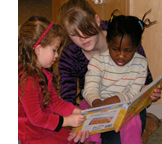Level 1: Grades 1 and 2 ~ Barn Swallows & Violet Green Swallows
|
The early years of formal education establish the foundation for much of students’ social, physical, cognitive and emotional development. During this crucial time, not only are students learning early literacy and math skills, they are also learning how to work with others and establishing their disposition toward school. That’s why we work so hard to create relevant, engaging, and nurturing learning experiences for our youngest students. We keep class sizes small - average 22 students -because research shows that small classes have academic and social benefits. Here is a brief description of how we help children develop social-emotional skills and how we teach reading, writing, math, science, social studies, art and physical education in Level 1.
|
Reading
Learning to Read
Level 1 students have a 90-minute literacy block daily. During that time, students receive 30 minutes of small group instruction, then spend 30 minutes in whole group instruction. The remaining 30 minutes are spent in other literacy activities, including spelling, independent reading or additional small group work. Some students work independently during literacy block while others receive additional targeted instruction, depending on the student's individual needs.
|
Reading to Learn
As part of our integrated approach to learning, students spend time working on projects related to the unit of study, such as gardens or forest. Students in Level 1 begin to learn how to access non-fiction texts, laying a foundation for more independent research in later grades. Level 1 students are also exposed to 'reading to learn' through teacher read-alouds during which teachers read to students and help them learn how to how to decode text and use reading strategies to understand what the text is saying.
|
Loving to Read
Reading is not just an important academic skill - it’s the key to all other learning at all ages. To develop strong reading skills - or any skill - we have to practice and, without a genuine interest in reading, practice is a battle. We encourage a love of reading by creating engaging in-class libraries with high-interest books, by giving students choice in what they read whenever possible, by reading aloud to students, by offering independent reading time and by sharing our own enthusiasm for reading. Level 1 classrooms have large book collections with a wide selection of fiction and non-fiction books for a wide range of reading levels.
Writing
Through writing, students express themselves, show what they’ve learned, and learn about the power of language. Writing skills develop over many years, but even in these early years, we focus on the process used by proficient writers, taking a piece from the drafting stage, to revision and editing, through to publishing. Throughout the school, teachers use a workshop model for writing instruction.Writers’ workshop begins with a brief lesson followed by students working independently on their current writing. During the independent writing time, teachers meet with students individually or in small groups to address emerging needs in their writing. Beginning writers aren’t expected to use conventional spelling because doing so can stall the writing process. As students learn more words and strategies from literacy instruction, spelling skills receive more focus. Students write in a range of genres and we place an emphasis on integrating writing into the thematic units and on writing for an authentic audience.
Mathematics
Math is the one subject area that Level 1 students study in grade levels instead of mixed-grade groupings. 1st- and 2nd-grade math classes meet four times a week for one hour. We use the Bridges in Mathematics curriculum, which focuses on problem solving and the development of mathematical reasoning, as well as Context for Learning, which focuses on the 'big ideas' in mathematics. Students work as a class, individually, in pairs and in small groups. There is a “working buzz” in the classroom during collaborative work time as children are encouraged to “talk math” with each other, sharing their problem-solving approach and receiving feedback from teacher and peers. By encouraging dialogue about math, we promote a sense of engagement in their mathematical understanding and seek to foster the same excitement and inherent interest in math as we do in reading.
Art
Level 1 students have art class twice weekly for 50 minutes. ALevel 1 art classes focus on laying the foundation for lifelong artistic exploration by introducing elements and principles of design. Throughout all art endeavors we encourage student voice and expression while helping students develop specific skills.
Physical Activity
Students in Level 1 have physical activity class twice weekly for an hour. The program at this level is designed to provide movement experiences that help students develop motor skills and the characteristics of teamwork and sportsmanship. Cooperative games give students in this age group the opportunity to learn self-control and practice taking turns.



